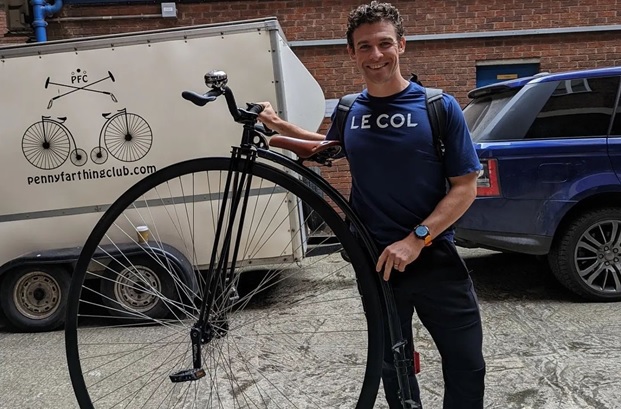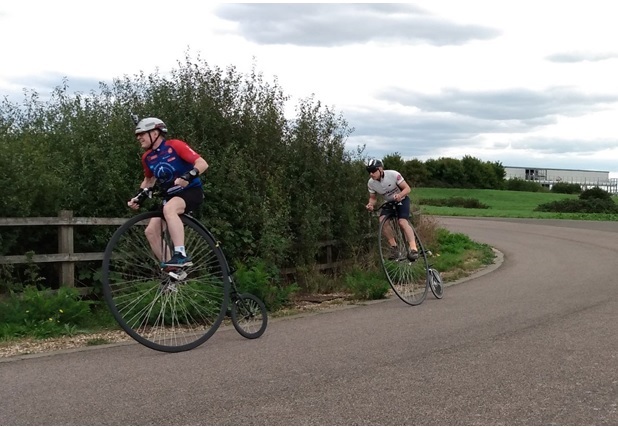Penny Farthing Bikes: Adjustments You Can Make
09/18/24
Take a look at your penny farthing bike. It doesn’t look like there are a lot of adjustments you can make, does it?
You wouldn’t be entirely right about that. While these machines, like unicycles, are somewhat limiting with respect to the size of the rider they can accommodate, there are actually some adjustments you can make.
That is to say, what you see doesn’t simply have to be what you get. Here are some adjustments you can make to your penny to improve comfort, handling, and more.
Wrapping the Handlebars
One of the first things you can do to improve comfort and grip is wrap your penny’s handlebars.
To do so, you’ll need some bar tape, scissors, and an Allen key. Remove some backing from the tape, start near the middle of the handlebars, and spiral the tape around the handlebars tightly.
Wrap to the end of the ridge at the end of the handlebar, then cut the bar tape and secure it in place with a good wrap of electrical tape.
Then replace the handlebar end and you’re good to ride. This modification will improve your grip of the handlebars.
Adjusting the Rear Steps
At the back of your penny farthing bike is a large rear step which is primarily used for mounting, but on which you can also stand when coasting downhill, or when braking, to apply more downward pressure on the rear wheel.
That one is welded to the frame and so it is not adjustable. However, beneath it there may be another step that is secured to the frame via a collar (which usually has a 5mm bolt).
If your penny farthing bike has this little secondary step, you can loosen the bolt and adjust the step to where you want it, on either the right or the left side. The height is also adjustable.
Adjusting this step can assist with mounting the unicycle but where and how you position it is a matter of rider preference.
Penny Farthing Bike Rake Adjustments

Many penny farthing bikes are also made with rear fork rakes that are adjustable, which will influence handling and control.
There should be one or two Allen key bolts (commonly 5mm) that are used to secure the rear fork rake in position. Loosen these, and pull the rear fork up or down to reposition the rake.
Don’t lower the rake too much, because you need to make sure that both bolts securing the rake and rear fork are in communication with each other.
“Raising the rake,” that is, adjusting the penny so that the front forks are more vertically aligned, pushes the center of gravity forward, over the front wheel.
This makes the penny a bit friskier, but it also gives the machine better control and speed for racing.
On the flipside, you can also lower the rake by decreasing the height of the rear fork which will push your center of gravity rearward (and lower it slightly) which can improve control, handling, and forgiveness, ever so slightly.
Really, it all comes down to what your goal is and how you want the penny farthing bike to handle.
Handlebar Adjustments
You can also adjust the handlebars of your penny farthing, though this is primarily an aesthetic adjustment. With that said, angling them forward may improve ergonomics slightly. Test out the adjustments and see what works for you.
The bar ends are a more important component of handlebar adjustment. They should be adjusted so that they are tilted slightly upward, which will prevent your hands from sliding off the front or ends of the bars.
Moreover, properly adjusting your handlebar ends will improve control and comfort, too.
Saddle Adjustments
How you adjust the rake will impact the angle of the saddle, so adjust your rake first, then take a look at the saddle.
The main thing to consider with the saddle is that it is nice and level, which for most riders, for all intents and purposes, will yield a more comfortable ride.
While the saddle cannot be lifted and lowered in the same manner as on a conventional bike (or unicycle) by loosening the seatpost clamp and adjusting the tube, you can reverse the manner in which the bracket is mounted, in order to raise or lower the seat.
With the seat lower is better for riders with shorter inseams; with it raised, it’s better for taller riders as this configuration will offer more legroom.
Crank Adjustments

Forget the different advantages of splined and square taper cranks for a second: look at the pedals themselves. You may notice there are other holes in the crank arm.
This is so that you can mount the pedals in different locations.
Closer to the hub axle will give you a smaller crank revolution, which is better for racing as most riders will be able to go faster.
Moving the pedal further away from the hub, towards the end of the crank arm, will afford better leverage and control, and as such is better for cruising, or for those that are learning to ride. Mounting the pedal at the longest distance is also better for climbing hills.
For More Information on Penny Farthing Adjustments
If you’re looking for more information on penny farthing bike adjustments, please see our YouTube channel - there’s a video called UDC Mk4 Penny Farthing Adjustments, where you can learn more.
Here for Seat Post Clamps, Square Taper Cranks, or Other Parts?
You can make most adjustments to a penny farthing bike, such as those mentioned here, quite easily, and you only need basic tools.
If you’re here for bike tools, or parts like safety gear, pedals, square taper cranks, or other parts or hardware, take a look through our catalog for more information.
In the event that you have more involved questions about penny farthings, learning how to ride, or what you need in order to make these adjustments mentioned here, get in touch with us directly.

